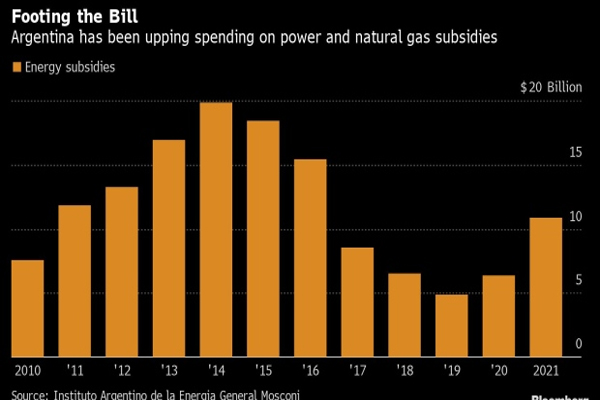
Jonathan Gilbert and Jorgelina do Rosario, Bloomberg News
BUENOS AIRES
EnergiesNet.com 03 04 2022
Argentina has hammered out an agreement with the International Monetary Fund over how to handle energy subsidies, presidential spokeswoman Gabriela Cerruti said on Thursday, clearing a key hurdle as the government looks to refinance over $40 billion with the multilateral lender.
The country plans to subsidize homes based on their income: The richest families will pay market prices, with subsidies kicking in for poorer households, Cerruti said. She wasn’t clear on the proposal for industrial energy users.
Argentina’s energy subsidy bill soared to $10.9 billion last year, according to the General Mosconi Argentine Energy Institute, and finding a way to reduce that spending was a sticking point in the country’s talks with the IMF for a new deal, which the government hopes to announce later Thursday, she added.
Read More: Argentina Reached a Deal With IMF Staff, President Says
Many Argentine homes and businesses pay far below market cost for power and natural gas, a wrecking ball for government finances and the business models of energy producers, transporters and distributors. But now the government “is determined to reach reasonable energy prices,” Cerruti told reporters.
Argentina is expected to announce additional specifics on its staff-level agreement with the IMF later on Thursday. Taking away subsidies is politically sensitive, as ex-President Mauricio Macri discovered to his detriment: He lasted one four-year term in office before getting voted out in 2019 after slashing annual subsidies to just $4.9 billion from $18.5 billion in 2015.
Read More: Argentina to Push Ahead With Means-Tested Energy Subsidies
The government will hold a public hearing at the end of April to discuss the plan. Large industrial users wouldn’t receive any subsidies, according to a statement sent after the press conference.
Here is how the subsidy system would work for households, with fee increases based on a local salary coefficient:
- A first segment of users will pay the fees completely and won’t be granted with any economic subsidy; they have “full payment capacity”
- A second segment will include users who fall under certain welfare programs and pay a “social fee”; their fee hike will be set at 40% of the previous year’s salary coefficient
- A third segment includes remaining home users; their fee hike is set at 80% of the previous year’s salary coefficient}
bloomberg.com 03 03 2022











